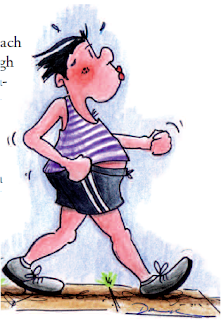The Way We Walk
http://dx.doi.org/10.1051/epn:2008504

几百年的进化使人类有充足的时间学会走路.行走是四处逛逛的一个相当好的方式,尽管比不了骑自行车.几个明显的特点使我们走得很有效率:我们的胳膊与腿逆相位摆动,这样使总的角动量大致为零.我们腿的摆动的固有频率,对于成人,大约为1Hz.军队正常行军每分钟120步,正好1Hz.如果迈一步是83厘米,相应的行军速度几乎正好是每分钟100米.漂亮!这一事实不能说明公制(米–千克–秒单位制)的优越性,但是,知道这一点对徒步旅行很有用.
从能量上讲,在水平面上行走是个有点特殊的事情, 爬楼梯要克服重力,划船或骑自行车要克服水或空气的阻力.行走特殊之处在于: 我们不需要克服外力.行走时,甚至气动阻力(正比于速度的平方)都可以忽略.我们产生的能量正是我们的身体耗散的能量.
有人可能纳闷,行走为什么还消耗能量.事实上,实验表明,行走过程中新陈代谢功率是每千克身体质量2.5W,这可从吸收的氧气量和产生的二氧化碳量推知.对于成人,这个功率大约为200W.为什么有那么多?这是因为人的行走在力学上是很复杂的,需要许许多多肌肉参与进来,科学家正发展各种理论来解释人的行走的能量消耗.
我们物理学家可以提供一条明显的线索:行走时,人的等效位移是水平的,但是每一步我们的质心被提高了大约4厘米.这可以用来说明代谢消耗功率为什么很高吗?这一简单的解释,感觉上很合理,然而,实验并不支持.密西根大学的rthur D. Kuo做的实验表明,有一种行走方式可以减小质心的位移,但不能减少代谢消耗,甚至使代谢消耗增大.当步长大于或小于我们通常的步长时,代谢消耗功率便上升,换句话,我们通常的走路方式是最有效的方式.
结论看来是很显然了,如果我们想走得最有效率,就不应想着我们学过的物理来优化我们的步伐.我们甚至要什么都不要想,只是走好了.如果对此还不满意,还有一个方法,回家骑车吧.
Centuries of evolution have given mankind plenty of time to learn how to walk. Walking is a reasonably efficient way of getting around, although not nearly as efficient as riding a bicycle. A few obvious features help us to walk efficiently: we move our arms and legs in antiphase, thus keeping the total angular momentum more or less zero. And we swing our legs at almost the natural pendulum frequency, which is around 1 Hz for adults. Indeed, traditional military marches proceed at 120 steps per minute: exactly 1 Hz. Given a standard step length of 83 cm, the corresponding marching speed is almost exactly 100 m per minute. Beautiful! This fact does not serve to illustrate the superiority of the metric system, but it sure is handy to know when hiking. Energetically speaking, walking on a horizontal surface is a special case. We have no external force to overcome, in contrast to climbing the stairs, for example, where we have to fight gravity to increase potential energy; or to rowing and cycling, where we have to overcome drag from water or air. Walking is different: even aerodynamic drag is negligible (remember that it is proportional to the square of the speed). All energy that we produce is dissipated by our own body. One may wonder why walking costs any energy at all. In fact, experiments show that the metabolic cost of walking, derived from oxygen consumption and carbon dioxide production, is about 2,5 W per kg of body mass. This is roughly 200 W for an adult. Why is that still so much? It is because human walking is mechanically complex. It involves the activity of numerous muscles, and various theories are being developed to arrive at a comprehensive description. As innocent physicists we may offer an obvious clue: the effective displacement may be horizontal, but our centre of mass must be raised by some 4 cm at each step. Could that account for the high metabolic cost? This simple explanation, tempting though it may be, is not supported by the evidence. Experiments by Arthur D. Kuo at the University of Michigan have shown that a walking pattern that reduces the displacement of the centre of mass, does not reduce metabolic cost. In fact, it makes the metabolic cost go up. Also when the step length is varied beyond our natural step length, the cost goes up. In other words: the way we normally walk is also the most efficient one. The conclusion seems to be inevitable. If we really want to walk more efficiently, we should not try to improve on our steps by thinking physics. We shouldn’t even think at all, just walk. And if we are still not satisfied with the result, there is only one alternative: go home and pick up our bicycle.


Leave your comment